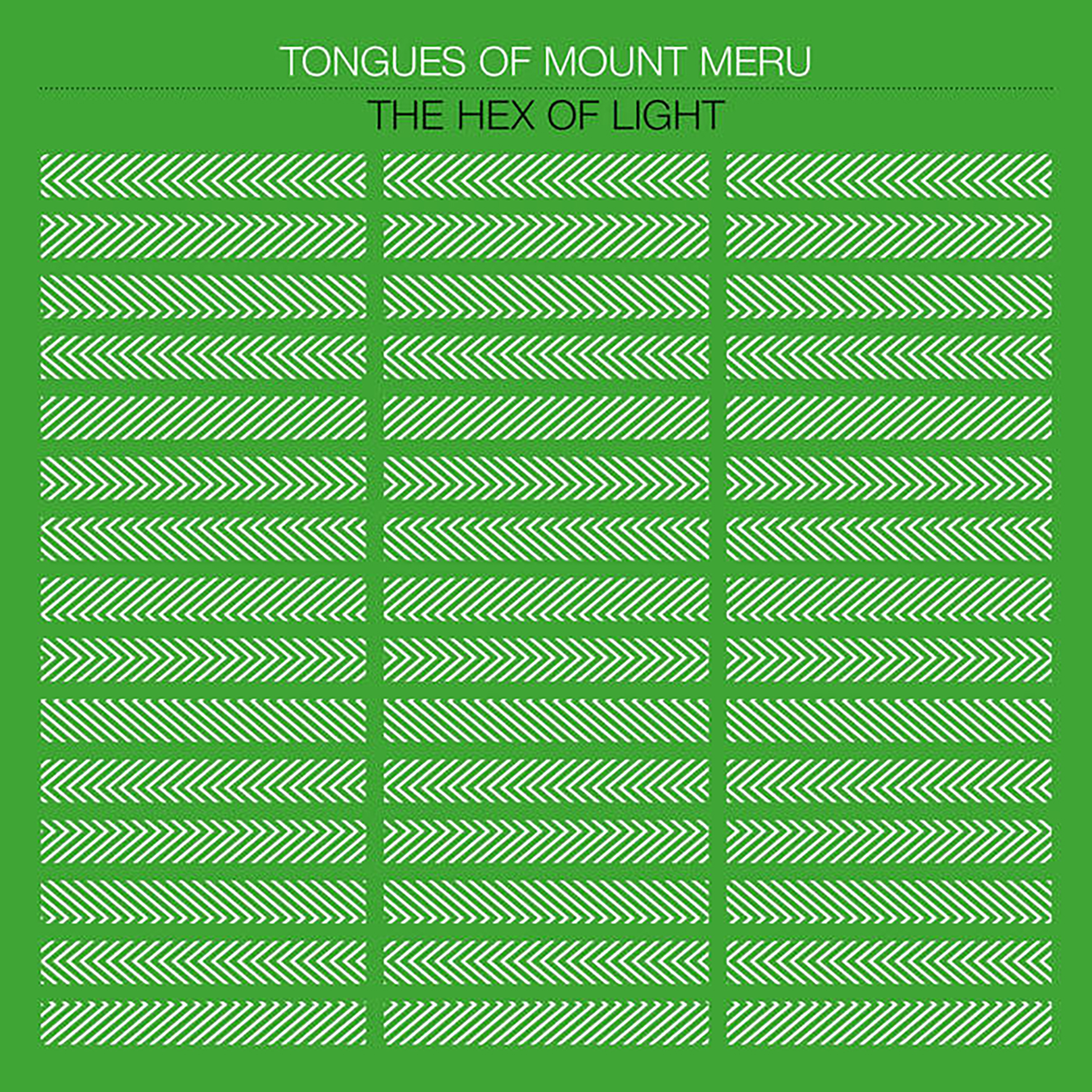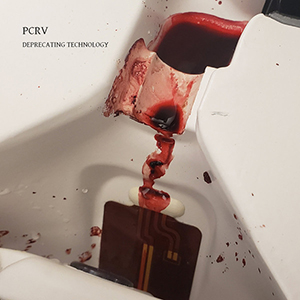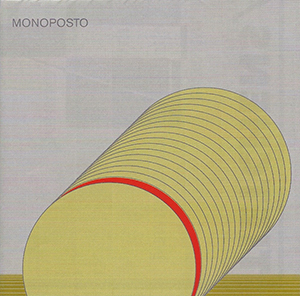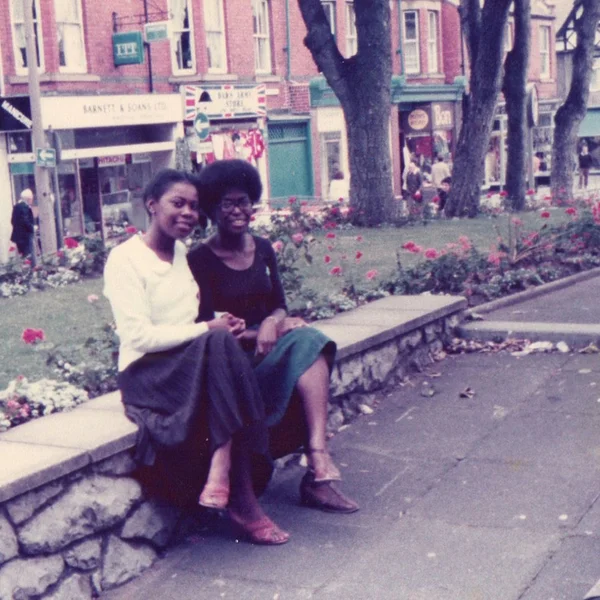 This latest release from Jon Wesseltoft and Lasse Marhaug's long-running (if fitful) drone project was recorded all the way back in 2013, which makes for quite a perplexing mystery, as I cannot understand why such a great album would remain on the shelf for so many years (especially since Marhaug himself runs a label). Most likely, however, The Hex of Light was simply the victim of Marhaug's incredibly prolific output, as well as Mount Meru's tendency to bounce from label to label with every release. Also, it appears as though this project was either on hiatus or completely defunct for quite some time, though Wesseltoft and Marhaug have performed together in Meru-esque form as recently as 2016. Aside from that, it is probably also safe to say that Wesseltoft poured quite a lot of time into mastering and editing this monster, as The Hex of Light's two longform pieces represent crushingly dense and mind-melting drone heaviness at its absolute best.
This latest release from Jon Wesseltoft and Lasse Marhaug's long-running (if fitful) drone project was recorded all the way back in 2013, which makes for quite a perplexing mystery, as I cannot understand why such a great album would remain on the shelf for so many years (especially since Marhaug himself runs a label). Most likely, however, The Hex of Light was simply the victim of Marhaug's incredibly prolific output, as well as Mount Meru's tendency to bounce from label to label with every release. Also, it appears as though this project was either on hiatus or completely defunct for quite some time, though Wesseltoft and Marhaug have performed together in Meru-esque form as recently as 2016. Aside from that, it is probably also safe to say that Wesseltoft poured quite a lot of time into mastering and editing this monster, as The Hex of Light's two longform pieces represent crushingly dense and mind-melting drone heaviness at its absolute best.
Two new shows just for you. We have squeezed out two extended release episodes for this weekend to get you through this week. They contain mostly new songs but there's also new issues from the vaults. The first show features music from Rider/Horse, Mint Field, Robert Aiki Aubrey Lowe, Anastasia Coope, ISAN, Stone Music, La Securite, Bark Psychosis, Jon Rose, Master Wilburn Burchette, Umberto, Wand, Tim Koh, Sun An, and Memory Drawings. The second episode has music by Laibach, Melt-Banana, Chuck Johnson, X, K. Yoshimatsu, Dorothy Carter, Pavel Milyakov, Violence Gratuite, Mark Templeton, Dummy, Endon, body / negative, Midwife, Alberto Boccardi, Divine. Cow in Maui from Veronika in Vienna. Get involved: subscribe, review, rate, share with your friends, send images! |



 Sarah Davachi is a luminary in the field of electroacoustic music, with a master's degree from Mills College and an in progress doctorate from UCLA. Her self-released album Horae builds on a noteworthy career that includes 17 releases and worldwide tours with such notable contemporaries as Grouper, William Basinski, and Oren Ambarchi. Named after Greek goddesses, this album evokes the same feelings and visceral reactions experienced when listening to similarly unstructured soundscapes found in nature. Describing the post of the horae at the gates to Olympus, this minimalist document is regal, stately, and emotionally potent.
Sarah Davachi is a luminary in the field of electroacoustic music, with a master's degree from Mills College and an in progress doctorate from UCLA. Her self-released album Horae builds on a noteworthy career that includes 17 releases and worldwide tours with such notable contemporaries as Grouper, William Basinski, and Oren Ambarchi. Named after Greek goddesses, this album evokes the same feelings and visceral reactions experienced when listening to similarly unstructured soundscapes found in nature. Describing the post of the horae at the gates to Olympus, this minimalist document is regal, stately, and emotionally potent. Anna Burch is the singular creative force behind so-called "bummer pop" album If You're Dreaming. This album is a departure from Burch's earlier effort, and one that shows off her stylistic breadth and thematic depth. In contrast to the high energy first album, for this release she slips into the fireside armchair and contemplates feelings and relationships, rocking gently and raising in inquiring brow. It's a relaxation of pace that I much prefer, and every song on the release is an instant favorite.
Anna Burch is the singular creative force behind so-called "bummer pop" album If You're Dreaming. This album is a departure from Burch's earlier effort, and one that shows off her stylistic breadth and thematic depth. In contrast to the high energy first album, for this release she slips into the fireside armchair and contemplates feelings and relationships, rocking gently and raising in inquiring brow. It's a relaxation of pace that I much prefer, and every song on the release is an instant favorite. In what appears to be his first solo release in five years, North Dakota resident Matt Taggart’s PCRV covers a bit of everything defined as noise on Deprecating Technology. Across the 40 minute duration of this tape he runs the full gamut: shrill sound collage, sustained wall noise, and even some hushed parts that would qualify as electro-acoustic. It might be all over the place on paper, but consistent production, as well as his use of what resembles vintage computer tones, makes for what truly sounds like a unified album.
In what appears to be his first solo release in five years, North Dakota resident Matt Taggart’s PCRV covers a bit of everything defined as noise on Deprecating Technology. Across the 40 minute duration of this tape he runs the full gamut: shrill sound collage, sustained wall noise, and even some hushed parts that would qualify as electro-acoustic. It might be all over the place on paper, but consistent production, as well as his use of what resembles vintage computer tones, makes for what truly sounds like a unified album. Concluding Die Stadt and Auf Abwegen's ambitious reissue program is Monoposto, a collaborative work between Asmus Tietchens and CV Liquidsky (Andreas Hoffmann) from 1991. Originally a vinyl only release, the album comes across as an approach to digital electronic instrumentation akin to his work in the analog domain from the 1980s. With prevalent guitar, and even a Neil Young cover, however, it makes for one of his more accessible and conventionally musical works.
Concluding Die Stadt and Auf Abwegen's ambitious reissue program is Monoposto, a collaborative work between Asmus Tietchens and CV Liquidsky (Andreas Hoffmann) from 1991. Originally a vinyl only release, the album comes across as an approach to digital electronic instrumentation akin to his work in the analog domain from the 1980s. With prevalent guitar, and even a Neil Young cover, however, it makes for one of his more accessible and conventionally musical works. JR Robinson and Esther Shaw explore the Greek philosophy of Stoicism and the path to happiness known as eudaimonia for this new album with the addition of Thor Harris (Swans) and Jamie Stewart (Xiu Xiu). This is a contrast to the prior album, The Alone Rush, which was steeped in personal tragedy. To achieve eudaimonia involves accepting the present moment as it exists, and not to be controlled by pleasure or fear of that moment. Wrekmeister Harmonies present a form of eudaimonia through We Love to Look at the Carnage with songs that expose the strength achieved through victory over darkness. Written in Oregon in near total isolation, the music feels like a winter evening in the Northern Hemisphere. Their translation of winter to sound is marked by understated grim simplicity, melodies syncopated with urgent resignation through orchestral gloom, and a mastery of emotional subtlety. It is an intensely intimate musical journey that begins at night but ends in the promise of a new day.
JR Robinson and Esther Shaw explore the Greek philosophy of Stoicism and the path to happiness known as eudaimonia for this new album with the addition of Thor Harris (Swans) and Jamie Stewart (Xiu Xiu). This is a contrast to the prior album, The Alone Rush, which was steeped in personal tragedy. To achieve eudaimonia involves accepting the present moment as it exists, and not to be controlled by pleasure or fear of that moment. Wrekmeister Harmonies present a form of eudaimonia through We Love to Look at the Carnage with songs that expose the strength achieved through victory over darkness. Written in Oregon in near total isolation, the music feels like a winter evening in the Northern Hemisphere. Their translation of winter to sound is marked by understated grim simplicity, melodies syncopated with urgent resignation through orchestral gloom, and a mastery of emotional subtlety. It is an intensely intimate musical journey that begins at night but ends in the promise of a new day. Three piece girl band Big Joanie hailing from the UK have made a splash internationally, opening for such luminaries as Sleater-Kinney and Bikini Kill and attracting much critical acclaim. Landing somewhere between thematically punk rock and musically pop rock, they manage to sound cool and direct while lamenting about men, sex, friendship, and modern life as black women.
Three piece girl band Big Joanie hailing from the UK have made a splash internationally, opening for such luminaries as Sleater-Kinney and Bikini Kill and attracting much critical acclaim. Landing somewhere between thematically punk rock and musically pop rock, they manage to sound cool and direct while lamenting about men, sex, friendship, and modern life as black women. This latest release from Student of Decay’s eclectic and unpredictable sister label is an unexpectedly melodic and accessible one, though it still fits comfortably within Soda Gong's ethos of exploring the more playful and trend-averse fringes of experimental music. While this is technically only Malkin's second solo album under his own name, he has been a prolific and ubiquitous figure in the LA scene for quite some time, surfacing in a number of different guises and collaborations. In fact, I just belatedly discovered that he played on one of my favorite songs from the Not Not Fun milieu (LA Vampires/Maria Minerva's "A Lover & A Friend"). Given that pedigree, it is not surprising that A Typical Night in the Pit has a very "LA" feel to it, but it is an endearingly vaporous and neon-lit one, evoking a kind of dreamlike and hazy strain of jazz. It maybe errs a bit too much on the side of atmosphere to feel like a truly substantial statement, but Malkin has both style for days and an impressively unerring instinct for manipulating light, space, and texture. If I saw a film with this as the soundtrack, I would definitely stick around to the end to find out who the hell managed to make smoky, noirish jazz sound so fresh and endearingly skewed.
This latest release from Student of Decay’s eclectic and unpredictable sister label is an unexpectedly melodic and accessible one, though it still fits comfortably within Soda Gong's ethos of exploring the more playful and trend-averse fringes of experimental music. While this is technically only Malkin's second solo album under his own name, he has been a prolific and ubiquitous figure in the LA scene for quite some time, surfacing in a number of different guises and collaborations. In fact, I just belatedly discovered that he played on one of my favorite songs from the Not Not Fun milieu (LA Vampires/Maria Minerva's "A Lover & A Friend"). Given that pedigree, it is not surprising that A Typical Night in the Pit has a very "LA" feel to it, but it is an endearingly vaporous and neon-lit one, evoking a kind of dreamlike and hazy strain of jazz. It maybe errs a bit too much on the side of atmosphere to feel like a truly substantial statement, but Malkin has both style for days and an impressively unerring instinct for manipulating light, space, and texture. If I saw a film with this as the soundtrack, I would definitely stick around to the end to find out who the hell managed to make smoky, noirish jazz sound so fresh and endearingly skewed. For the most part, I can always be relied upon to enthusiastically support any talented artist who leaves their comfort zone behind to explore increasingly weird and uncharted territory. I do have my weaknesses, however, and one of the major ones is my undying love for classic Mille Plateaux/Chain Reaction-style dub techno. Consequently, I am hopelessly fixated on early Vladislav Delay albums like Entain and the newly reissued Multila. That is a damn shame, as Sasu Ripatti has made quite a lot of wonderful and forward-thinking music since and I have definitely not dug into his later work nearly as much as I should. This latest album, the first new Vladislav full-length in roughly five years, is a particularly effective and timely reminder that I am an absolute chump for sleeping on many of Ripatti's major statements over the years. Rakka is quite an ambitiously intense and inventive affair, seamlessly blurring together elements of Tim Hecker-style blown-out ambiance, power electronics, techno deconstruction, and production mastery into an explosive tour de force.
For the most part, I can always be relied upon to enthusiastically support any talented artist who leaves their comfort zone behind to explore increasingly weird and uncharted territory. I do have my weaknesses, however, and one of the major ones is my undying love for classic Mille Plateaux/Chain Reaction-style dub techno. Consequently, I am hopelessly fixated on early Vladislav Delay albums like Entain and the newly reissued Multila. That is a damn shame, as Sasu Ripatti has made quite a lot of wonderful and forward-thinking music since and I have definitely not dug into his later work nearly as much as I should. This latest album, the first new Vladislav full-length in roughly five years, is a particularly effective and timely reminder that I am an absolute chump for sleeping on many of Ripatti's major statements over the years. Rakka is quite an ambitiously intense and inventive affair, seamlessly blurring together elements of Tim Hecker-style blown-out ambiance, power electronics, techno deconstruction, and production mastery into an explosive tour de force. Alison Chesley, a classically trained cellist, is one of those performers whose collaborations are many and varied, spanning across genres and decades in her long career. Her credits include contributions to over 100 albums
Alison Chesley, a classically trained cellist, is one of those performers whose collaborations are many and varied, spanning across genres and decades in her long career. Her credits include contributions to over 100 albums
